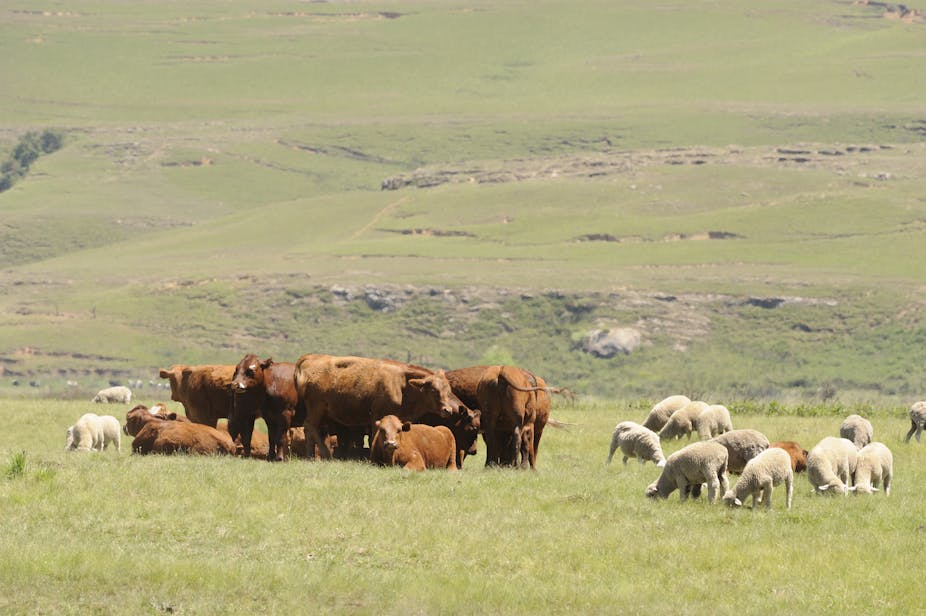Much of South Africa has good grazing for livestock. And sheep, goats and cattle have played an important role in the history of the region’s diverse cultures. But how did these animals get here?
For a long time scholars were convinced that the first livestock in southern Africa had to have come along with a significant migration of people from north as far as Egypt. This view became prevalent after the first European settlement was established in 1652 where Cape Town stands today. The settler community was largely concerned with obtaining livestock from the local Khoekhoen herders, the antecedents of the Nama people who still speak that language.
Nineteenth century scholars thought Khoekhoen and their herds had originally come from far to the north. Later, the source of the Khoekhoen was thought to have been further south, perhaps in East Africa or the Zambezi Basin. Another theory was that livestock was brought southwards along the Atlantic seaboard through Angola and Namibia to the Cape of Good Hope and beyond. Lately however this theory had fallen out of favour.
In all cases, however, scholars were convinced that the first livestock in southern Africa had to have come along with a significant migration of people from the north. This was typical colonial thinking, attributing all economic innovations – like livestock herding – to northerners since the locals were not considered innovative enough. Even today the conventional view still holds that a migratory event in the north resulted in livestock coming to South Africa.
But can such thinking still be supported in the 21st century?
New research, new thoughts
There is no doubt – and never has been – that livestock must have come from the North, ultimately the Near East. At issue is who brought them and what was the mechanism: a migration of a large number of livestock herders? Or small scale infiltration of herders, perhaps only young males? Perhaps a sort of down-the-line relay with one group of herders passing livestock to their neighbours and so on.
New research based on a detailed reexamination of stone tools and ancient ceramic vessel shards it seems that it was the northern San people who introduced the first sheep to South Africa. They are the non-Khoe speaking indigenous hunter-gatherers of the northern parts of southern Africa who are close relatives of the ethnographically famous Kalahari “Bushmen”. Where and how they obtained the livestock remains unclear, principally because for the past few decades there has been little relevant archaeological research in Zambia and Tanzania.
Complicating the story, recent reports indicate that the first sheep may have arrived in South Africa several centuries earlier than previously thought. Bones identified as domesticated sheep, which were excavated from the Blydefontein shelter in the upper Karoo, have been dated to 2700 years ago. But the analysis of ancient DNA from these bones suggests that they may be of wild bovids.
Where livestock hailed from
The colonial view relied on the fact that livestock are not native to southern Africa. The wild ancestors of African sheep, goats and cattle were all first domesticated in southwestern Asia and cattle perhaps also in northeastern Africa.
The origins of the language of the seventeenth century Cape Khoekhoen, proto-Khoe, is also convincingly traced to East Africa by historical linguists. Since the language of the Cape Khoekhoen and the livestock must have originally come from the lands to the north of the River Zambezi, the assumption was made that they probably came together in one migratory event.
The parsimonious, or most economical, explanation is that these events were related: Khoe-speakers brought the earliest livestock. This is the researcher’s equivalent of killing two birds with one stone. Since the mid-1970s the view has held that proto-Khoe-speaking people in a region between the Zambezi River and East Africa first acquired livestock and the necessary herding skills from other populations to their north around 2,000 years ago. The putative other populations were thought to have been Bantu-speakers who spread out of their homeland in west-central Africa, beginning some 5 000 or 6 000 years ago.
This view is now challenged by a sizeable collection of sheep bones dated using a complex chemical technique known as radiocarbon dating. The oldest southern African livestock bones are several centuries older than the first villages of the Bantu-speaking farmers and metallurgists in the Zambezi basin. The oldest livestock bones also invariably occur in typical Later Stone Age sites, usually rock shelters, known to have been occupied by the indigenous San hunter-gatherers of southern Africa.
Early sheep
And now a re-analysis of stone tools from many previously excavated sites all across southern Africa seems to have located the first herders. The sub-continental distribution of a particular stone toolkit matches the distribution of northern San genes and languages, and it is precisely that stone toolkit which is found in the South African rock shelter sites with the oldest sheep bones. This indicates the high probability that the earliest sheep reached southernmost Africa by one or more sporadic infiltrations by small groups of northern San hunter-gatherers.
The earliest sheep seem to have arrived in such an infiltration event in the last few centuries BC along the Atlantic seaboard. That is at least two or three centuries before the earliest farming villages appeared in the Zambezi basin and on the east coast of southern Africa. The earliest arrival of livestock seems to have had few consequences or implications for the continuation of a basically southern African Later Stone Age hunting and gathering way of life. Hunting and gathering remained the main subsistence activity despite the availability of livestock.
For now, indications are that the Khoe-speakers may not have arrived with the first livestock, but a little later, perhaps around the same time as the first bantu-speaking farmers of the so-called Iron Age.
The moral of the story seems to be that the most parsimonious answer is not always the correct one.

